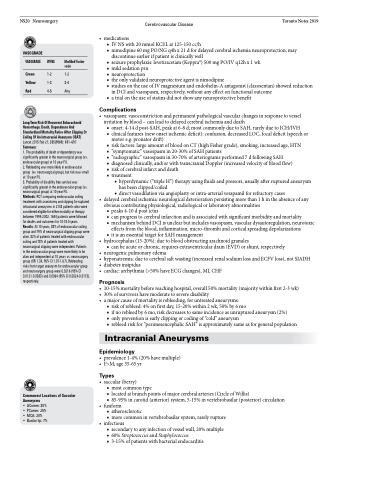Page 818 - TNFlipTest
P. 818
NS20 Neurosurgery
Cerebrovascular Disease Toronto Notes 2019
• medications
■ IV NS with 20 mmol KCl/L at 125-150 cc/h
■ nimodipine 60 mg PO/NG q4h x 21 d for delayed cerebral ischemia neuroprotection; may
discontinue earlier if patient is clinically well
■ seizure prophylaxis: levetiracetam (Keppra®) 500 mg PO/IV q12h x 1 wk
■ mild sedation prn
■ neuroprotection
■ the only validated neuroprotective agent is nimodipine
■ studies on the use of IV magnesium and endothelin-A antagonist (clazosentan) showed reduction
in DCI and vasospasm, respectively, without any effect on functional outcome ■ a trial on the use of statins did not show any neuroprotective benefit
Complications
• vasospasm:vasoconstrictionandpermanentpathologicalvascularchangesinresponsetovessel irritation by blood – can lead to delayed cerebral ischemia and death
■ onset: 4-14 d post-SAH, peak at 6-8 d; most commonly due to SAH, rarely due to ICH/IVH
■ clinical features (new onset ischemic deficit): confusion, decreased LOC, focal deficit (speech or
motor e.g. pronator drift)
■ risk factors: large amount of blood on CT (high Fisher grade), smoking, increased age, HTN ■ “symptomatic” vasospasm in 20-30% of SAH patients
■ “radiographic” vasospasm in 30-70% of arteriograms performed 7 d following SAH
■ diagnosed clinically, and/or with transcranial Doppler (increased velocity of blood flow)
■ risk of cerebral infarct and death
■ treatment
◆ hyperdynamic (“triple H”) therapy using fluids and pressors, usually after ruptured aneurysm has been clipped/coiled
◆ direct vasodilation via angioplasty or intra-arterial verapamil for refractory cases
• delayedcerebralischemia:neurologicaldeteriorationpersistingmorethan1hintheabsenceofany
obvious contributing physiological, radiological or laboratory abnormalities
■ peaks 4-10 d post ictus
■ can progress to cerebral infarction and is associated with significant morbidity and mortality
■ mechanism behind DCI is unclear but includes vasospasm, vascular dysautoregulation, neurotoxic
effects from the blood, inflammation, micro-thrombi and cortical spreading depolarizations ■ it is an essential target for SAH management
• hydrocephalus (15-20%): due to blood obstructing arachnoid granules
■ can be acute or chronic, requires extraventricular drain (EVD) or shunt, respectively
• neurogenicpulmonaryedema
• hyponatremia:duetocerebralsaltwasting(increasedrenalsodiumlossandECFVloss),notSIADH • diabetesinsipidus
• cardiac: arrhythmia (>50% have ECG changes), MI, CHF
Prognosis
• 10-15%mortalitybeforereachinghospital,overall50%mortality(majoritywithinfirst2-3wk) • 30%ofsurvivorshavemoderatetoseveredisability
• amajorcauseofmortalityisrebleeding,foruntreatedaneurysms:
■ risk of rebleed: 4% on first day, 15-20% within 2 wk, 50% by 6 mo
■ if no rebleed by 6 mo, risk decreases to same incidence as unruptured aneurysm (2%)
■ only prevention is early clipping or coiling of “cold” aneurysm
■ rebleed risk for “perimesencephalic SAH” is approximately same as for general population
Intracranial Aneurysms
Epidemiology
• prevalence1-4%(20%havemultiple) • F>M;age35-65yr
Types
• saccular(berry)
■ most common type
■ located at branch points of major cerebral arteries (Circle of Willis)
■ 85-95% in carotid (anterior) system, 5-15% in vertebrobasilar (posterior) circulation
• fusiform
■ atherosclerotic
■ more common in vertebrobasilar system, rarely rupture
• infectious
■ secondary to any infection of vessel wall, 20% multiple ■ 60%StreptococcusandStaphylococcus
■ 3-15% of patients with bacterial endocarditis
VASOGRADE
VASOGRADE WFNS
Green 1-2 Yellow 1-3 Red 4-5
Modified Fischer scale
1-2 3-4 Any
Long-Term Risk Of Recurrent Subarachnoid Hemorrhage, Death, Dependence And Standardized Mortality Ratios After Clipping Or Coiling Of An Intracranial Aneurysm (ISAT) Lancet 2015 Feb 21; 385(9969): 691–697 Summary:
1. The probability of death or dependency was significantly greater in the neurosurgical group (vs. endovascular group) at 10 year FU.
2. Rebleeding was more likely in endovascular group (vs. neurosurgical group), but risk was small at 10 year FU.
3. Probability of disability free survival was significantly greater in the endovascular group (vs. neurosurgical group) at 10 year FU.
Methods: RCT comparing endovascular coiling treatment with craniotomy and clipping for ruptured intracranial aneurysms in 2143 patients who were considered eligible for either modality or therapy between 1994-2002. 1644 patients were followed for deaths and outcomes for 10-18.5 years. Results: At 10 years, 83% of endovascular coiling group and 79% of neurosurgical clipping group were alive. 82% of patients treated with endovascular coiling and 78% of patients treated with neurosurgical clipping were independent. Patients in the endovascular group were more likely to be alive and independent at 10 years vs. neurosurgery group (OR 1.34, 95% CI 1.07-1.67). Rebleeding
risks from target aneurysm for endovascular group and neurosurgery group were 0.0216 (95% CI 0.0121-0.0383) and 0.0064 (95% CI 0.0024-0.0173), respectively.
Commonest Locations of Saccular Aneurysms
• AComm: 30%
• PComm: 25%
• MCA: 20%
• Basilar tip: 7%


